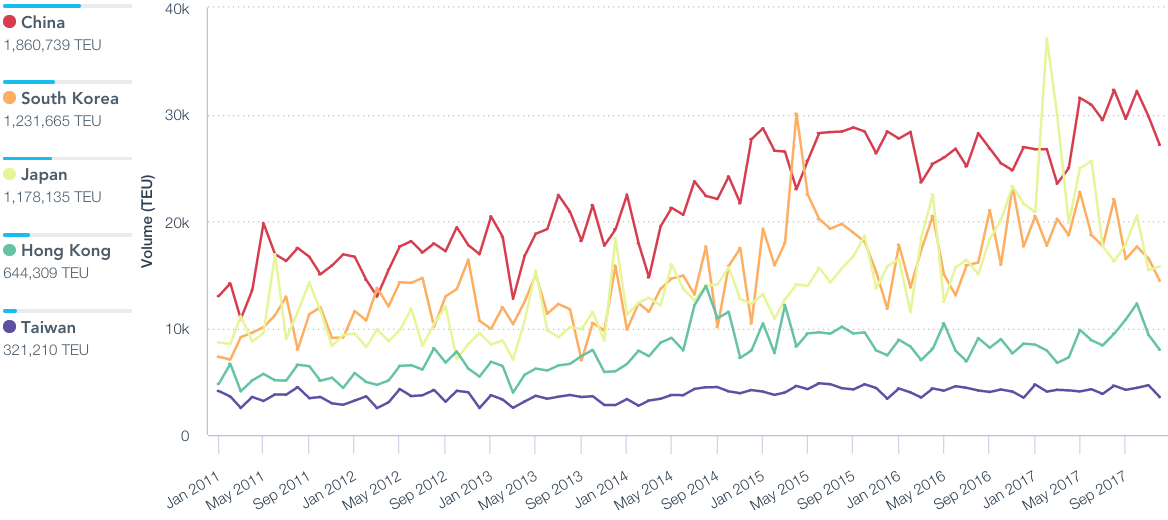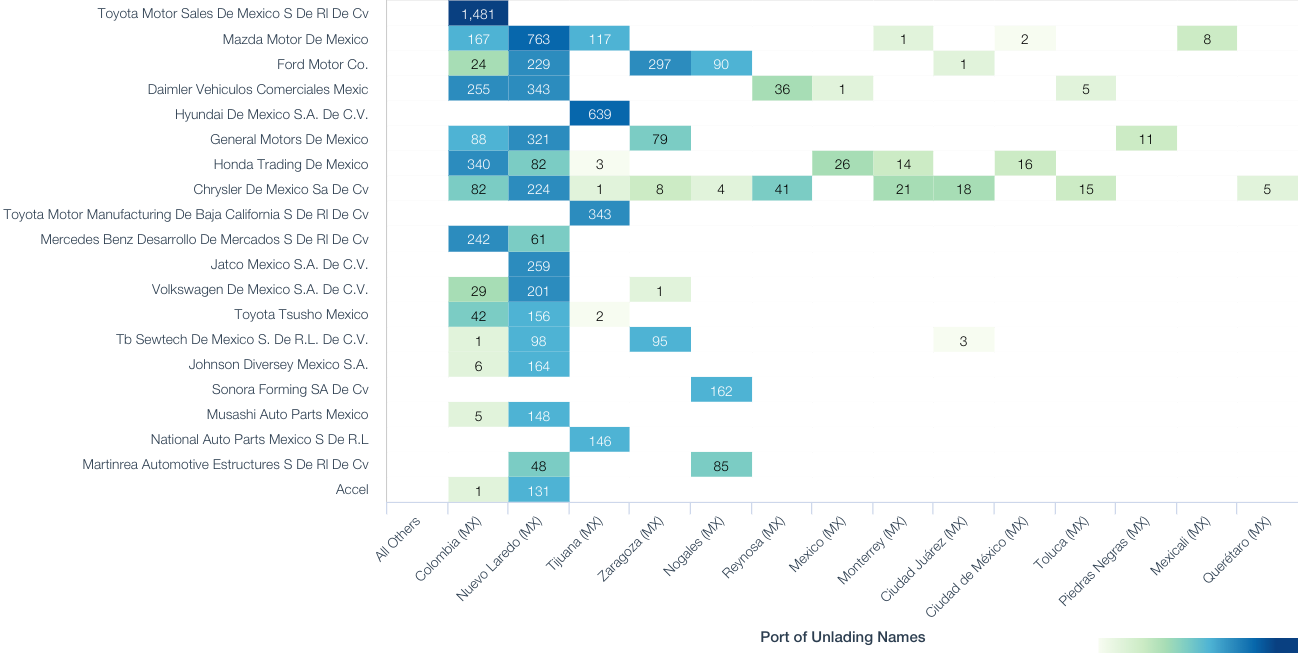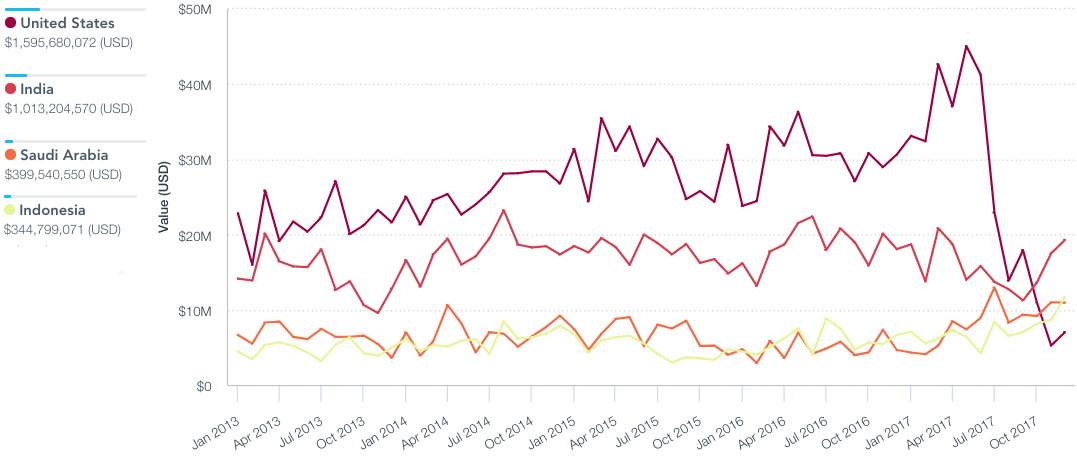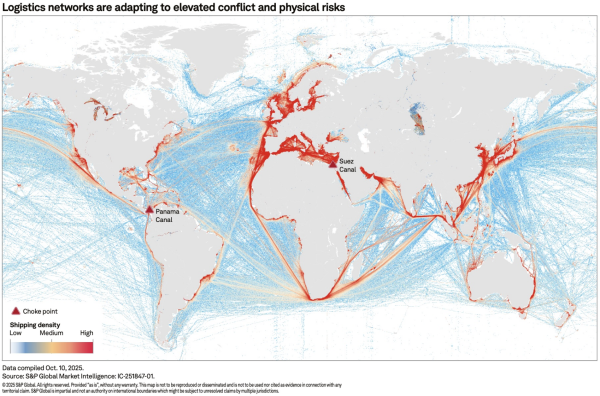Mexican logistics are in focus as CMA-CGM’s APL launches a new set of Asia-Americas services and we take a look at Ryder’s new Texas facility in the context of NAFTA. The U.S. has applied tariffs against Chinese aluminum foil, ahead of the big s232 decision. Also: trade deficits in the U.S. and Mexico; Huawei’s telecoms equipment exports; China’s duties on MMA; Peru’s timber export rules; steel complaints from South Korea, Mexico and the EU; U.S. prospects for TPP; and a “veto proof” block for NAFTA termination.
Daily Datum: $74 billion
U.S. advance trade-in-goods deficit, the highest since July 2008
NEED TO KNOW
CMA-CGM Relies on Need For Speed in Asia-Americas Service as Volumes Slow
CMA-CGM’s APL Shipping has launched three new trans-Pacific services between four Asian markets (including China) and 10 central- and south-American countries (including Mexico). The service will reportedly have the fastest South Korea-Mexico service in the industry at 15 days.
That competitive edge will matter as shipping from the four countries to Mexico have been in decline after a 12% drop in volumes in 2017, led by an 18% slump in shipments from South Korea and 27% from Japan.
APL has chosen its targets carefully though as volumes specifically into Manzanillo and Cardenas – the ports actually served – rose 9% as traffic consolidated away from smaller ports. The largest routes will be China-Manzanillo (210k TEUs in 2017) and Japan-Manzanillo (12%). Competition for volumes on other parts of the services may be stiffer though, with imports into Peru having fallen 13% in the 12 months to January 31.
Read more →

Source: Panjiva
Ryder Raises Rides for U.S.-Mexico Auto-Parts As NAFTA Uncertainty Looms
Trucking services provider Ryder System has expanded its U.S.-Mexico operations with a new facility in Laredo, Texas that will include automotive services. That comes as uncertainty reigns regarding automotive supply chains due to the debate about rules of origin in ongoing NAFTA negotiations.
Yet, these are more likely to cut imports of parts from outside NAFTA. Indeed, these could even increase cross-border traffic for Ryder, unless Mexican assembly is shuttered by automakers in favor of highly integrated U.S. operations. The shipping of parts into Mexico from the U.S. by truck climbed 10% in the fourth quarter of 2017 vs. 4% for the year as a whole. The largest potential customers on U.S.-to-Mexico routes include Toyota into Colombia Laredo (18% of shipments), Mazda (9% into Nuevo Laredo) and Hyundai (8%, into Tijuana).
Read more →

Source: Panjiva
China Foiled, Russia and Brazil Gain While Consumers Lose from Aluminum Case
The U.S. Commerce Department has made final duty determinations against Chinese aluminum foil exports with anti-dumping rates of up to 106%. While separate to the ongoing section 232 review of primary aluminum imports, this case does squeeze one of the few major Chinese aluminum products still exported to the U.S.
The case has been largely successful, with imports in the three months to January 31 having fallen 78% on a year earlier. That’s been partly offset, however, by a 149% rise in non-Chinese supplies including those from Brazil and Russia. Additionally consumer costs have likely increased after average import values per ton rose 27% in the fourth quarter on a year earlier. Chinese suppliers meanwhile have moved on to other markets, with total exports having climbed 11.2% in the fourth quarter on a year earlier after a surge in shipments to Saudi Arabia and Indonesia.
Read more →

Source: Panjiva
Global Trade Wrap
The U.S. advance trade-in-goods deficit climbed 9% on a year earlier to reach $74 billion, the highest since July 2008 and above economists’ expectations. Imports outpaced exports – not a surprise given recent maritime port performance – though import growth of 7% was partly down to oil prices. A 10% surge in capital goods imports was driven by buoyant corporate investment. The rise in the deficit may act as a spur to the Trump administration to deliver its section 232 (metals) and section 301 (China) tariffs sooner rather than later. (Panjiva Research – Policy)
On a similar tack the Mexican deficit surged 27% higher to reach $4.4 billion, the highest on record. As with the U.S. an increase in imports of 14% was the result of higher fuel prices and a 19% leap in capital goods imports. That likely reflects a step-up in purchases from China (full details are not yet available) while the status of the all-critical trade surplus vs. the U.S. has yet to be revealed. (Panjiva Research – Policy)
With the Mobile World Congress going on this week there is a focus on 5G telecoms network rollout plans. Huawei has announced it is running 30 trials globally, but not in the U.S. Its exports of telecoms network equipment from China have gone through a renaissance, rising 16% in the fourth quarter on a year earlier vs. a 22% fall in the prior three quarters. (Panjiva Research – Industries)
Returning to trade investigations, China has decided to increase duties on imports of MMA (a plexiglas precursor) from three countries including Japan. The original tariffs, set in 2015, have not prevented a rise in imports. That reached 32% in 4Q 2017 on a year earlier, led by a 46% jump in shipments from Japan. (Panjiva Research – Industries)
The U.S. Trade Representative has called on the Peruvian government to ensure the enforcement of timber export rules after illegal logging by Oroza was discovered last October. Exports of forestry products from Peru have been in a long-term decline, including a 9% drop in exports in January to reach the lowest since at least 2012. That’s been due to hardwood flooring shipments to China dropping rather than raw timber to the U.S. (Panjiva Research – Industries)
Steel (1): The forthcoming U.S. steel tariffs, to be decided by President Trump by April 11, are already drawing threats of retaliation. As discussed in our 2/26 report not all countries will have significant leverage though. South Korean Trade Minister Kim Hyun-chong will meet with U.S. Trade Representative Robert Lighthizer to discuss the tariffs. However, its leverage may be limited by KORUS negotiations that may be on the table too. (Korea Herald)
Steel (2): On a similar tack Mexico’s Economy Minister, Ildefonso Guajardo, will meet with U.S. Commerce Secretary Ross to discuss the metals plans. Our analysis of 2/26 indicates Mexico may have some leverage given Mexico’s imports of American steel and aluminum reached $14.6 billion last year, and many alternative supplies exist. The talks will be complicated by ongoing NAFTA negotiations however. (Reuters)
Steel (3): For good measure the EU Trade Commissioner Cecilia Malmstroem has stated the EU is “ready to take countermeasures” against a U.S. steel or aluminum move including “retaliatory measures” and a WTO reference. That’s not a surprise, with similar threats having been made last year, as shown in our 6/20 research. (Bloomberg, paywall)
NAFTA Watch (1): U.S. Treasury Secretary Steven Mnuchin has stated that discussions regarding the U.S. rejoining the Trans-Pacific Partnershiphave begun at a “high level”. Such a move seems unlikely in the coming year with the CPTPP only having recently been agreed in principle, as outlined in our 1/24 analysis. Furthermore CPTPP also includes Canada and Mexico, and so any moves from the U.S. could lead to yet another re-opening of NAFTA (assuming talks are completed) to make it CPTPP compliant. (New York Times)
NAFTA Watch (2): The administration of President Trump may not have free rein in NAFTA negotiations, however. If talks reach a successful conclusion there will need to be an “up-down” vote in Congress, which itself will be a function of timing given the forthcoming midterm elections. Importantly though Senate Finance Committee Chairman Orrin Hatch has indicated Congress would look to apply a “veto-proof” method to prevent the President from unilaterally withdrawing from NAFTA. As discussed in our 10/25 report the threat of termination has been an on-again, off-again affair, but remains the largest piece of leverage the administration has. (Inside Trade)




